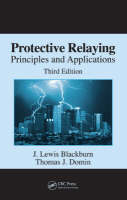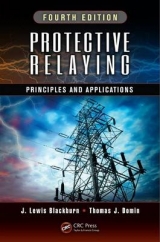
Protective Relaying
Crc Press Inc (Verlag)
978-1-57444-716-3 (ISBN)
- Titel erscheint in neuer Auflage
- Artikel merken
Technological advances and structural changes within the electric utility industry mandate that protection engineers develop a solid understanding of the related new technologies as well as of power system operations and economics in order to function proficiently. Continuing in the bestselling tradition of the previous editions by the late J. Lewis Blackburn, Protective Relaying: Principles and Applications, Third Edition retains the fundamentals of protection relays and power system protection while incorporating new developments in the field. Thoroughly updated and revised, this third edition focuses on technological changes in the design of protective systems, the practical concerns of power system protection encountered by users, and the techniques for protecting typical facilities used in modern power systems.
New to the Third Edition
Expanded coverage of the requirements for generator intertie protection, generator protection, and generator excitation systems
The latest technologies in microprocessor applications, including digital-based devices and designs
Protection issues, such as capacitor bank protection, underfrequency and undervoltage load shedding, special protection schemes, DC tripping scheme designs, fault location, and event reports
Building on the excellence of the preceding editions, this book will continue to serve as a basic reference for newcomers to the area as well as for experienced engineers. By sharing his first-hand experience with protection practices, the author offers valuable realistic insight into this field.
PREFACES
INTRODUCTION AND GENERAL PHILOSOPHIES
Introduction and Definitions
Typical Protective Relays and Relay Systems
Typical Power Circuit Breakers
Nomenclature and Device Numbers
Typical Relay and Circuit Breaker Connections
Basic Objectives of System Protection
Factors Affecting the Protection System
Classification of Relays
Protective Relay Performance
Principles of Relay Application
Information for Application
Structural Changes within the Electric Power Industry
Reliability and Protection Standards
Bibliography
FUNDAMENTAL UNITS: PER UNIT AND PERCENT VALUES
Introduction
Per Unit and Percent Definitions
Advantages of Per Unit and Percent
General Relations between Circuit Quantities
Base Quantities
Per Unit and Percent Impedance Relations
Per Unit and Percent Impedances of Transformer Units
Per Unit and Percent Impedances of Generators
Per Unit and Percent Impedances of Overhead Lines
Changing Per Unit (Percent) Quantities to Different Bases
Bibliography
PHASORS AND POLARITY
Introduction
Phasors
Circuit and Phasor Diagrams for a Balanced Three-Phase Power System
Phasor and Phase Rotation
Polarity
Application of Polarity for Phase-Fault Directional Sensing
Directional Sensing for Ground Faults: Voltage Polarization
Directional Sensing for Ground Faults: Current Polarization
Other Directional-Sensing Connections
Application Aspects of Directional Relaying
Summary
SYMMETRICAL COMPONENTS: A REVIEW
Introduction and Background
Positive-Sequence Set
Nomenclature Convenience
Negative-Sequence Set
Zero-Sequence Set
General Equations
Sequence Independence
Positive-Sequence Sources
Sequence Networks
Shunt Unbalance Sequence Network Interconnections
Example: Fault Calculations on a Typical System Shown in Figure 4.16
Example: Fault Calculation for Autotransformers
Example: Open-Phase Conductor
Example: Open Phase Falling to Ground on One Side
Series and Simultaneous Unbalances
Overview
Summary
Bibliography
Appendix 1: Short-Circuit MVA and Equivalent Impedance
Appendix 2: Impedance and Sequence Connections for Transformer Banks
Appendix 3: Sequence Phase Shifts through Wye-Delta Transformer Banks
RELAY INPUT SOURCES
Introduction
Equivalent Circuits of Current and Voltage Transformers
Current Transformers for Protection Applications
Current Transformer Performance on a Symmetrical AC Component
Secondary Burdens during Faults
CT Selection and Performance Evaluation for Phase Faults
Performance Evaluation for Ground Relays
Effect of Unenergized CTs on Performance
Flux Summation Current Transformer
Current Transformer Performance on the DC Component
Summary: Current Transformer Performance Evaluation
Current Transformer Residual Flux and Subsidence Transients
Auxiliary Current Transformers in CT Secondary Circuits
Voltage Transformers for Protective Applications
Optical Sensors
Bibliography
PROTECTION FUNDAMENTALS AND BASIC DESIGN PRINCIPLES
Introduction
Differential Principle
Overcurrent-Distance Protection and the Basic Protection Problem
Backup Protection: Remote vs. Local
Basic Design Principles
Ground Distance Relays
Solid-State Microprocessor Relays
Summary
Bibliography
SYSTEM-GROUNDING PRINCIPLES
Introduction
Ungrounded Systems
Transient Overvoltages
Grounded-Detection Methods for Ungrounded Systems
High-Impedance Grounding Systems
System Grounding for Mine or Other Hazardous-Type Applications
Low-Impedance Grounding
Solid (Effective) Grounding
Ferroresonance in Three-Phase Power Systems
Safety Grounding
Grounding Summary and Recommendations
References
GENERATOR PROTECTION/INTERTIE PROTECTION FOR DISTRIBUTED GENERATION
Introduction
Generator Connections and Overview of Typical Protection
Stator Phase-Fault Protection for All Size Generators
Unit Transformer Phase-Fault Differential Protection (87TG)
Phase-Fault Backup Protection (51V) or (21)
Negative-Sequence Current Backup Protection
Stator Ground-Fault Protection
Multiple Generator Units Connected Directly to a Transformer: Grounding and Protection
Field Ground Protection (64)
Generator Off-Line Protection
Reduced or Lost Excitation Protection (40)
Generator Protection for System Disturbances and Operational Hazards
Loss of Voltage Transformer Signal
Generator Breaker Failure
Excitation System Protection and Limiters
Synchronous Condenser Protection
Generator-Tripping Systems
Station Auxiliary Service System
Distributed Generator Intertie Protection
Protection Summary
Bibliography
TRANSFORMER, REACTOR, AND SHUNT CAPACITOR PROTECTION
Transformers
Factors Affecting Differential Protection
False Differential Current
Transformer Differential Relay Characteristics
Application and Connection of Transformer Differential Relays
Example: Differential Protection Connections for a Two-Winding Wye-Delta Transformer Bank
Load Tap-Changing Transformers
Example: Differential Protection Connections for Multiwinding
Transformer Bank
Application of Auxiliaries for Current Balancing
Paralleling CTs in Differential Circuits
Special Connections for Transformer Differential Relays
Differential Protection for Three-Phase Banks of Single-Phase Transformer Units
Ground (Zero-Sequence) Differential Protection for Transformers
Equipment for Transfer Trip Systems
Mechanical Fault Detection for Transformers
Grounding Transformer Protection
Ground Differential Protection with Directional Relays
Protection of Regulating Transformers
Transformer Overcurrent Protection
Transformer Overload-Through-Fault-Withstand Standards
Examples: Transformer Overcurrent Protection
Transformer Thermal Protection
Overvoltage on Transformers
Summary: Typical Protection for Transformers
Reactors
Capacitors
Power System Reactive Requirements
Shunt Capacitor Applications
Capacitor Bank Designs
Distribution Capacitor Bank Protection
Designs and Limitation of Large Capacitor Banks
Protection of Large Capacitor Banks
Series Capacitor Bank Protection
Capacitor Bank Protection Application Issues
Bibliography
BUS PROTECTION
Introduction: Typical Bus Arrangements
Single Breaker-Single Bus
Single Buses Connected with Bus Tie
Main and Transfer Buses with Single Breaker
Single Breaker-Double Bus
Double Breaker-Double Bus
Ring Bus
Breaker-and-Half Bus
Transformer-Bus Combination
General Summary of Buses
Differential Protection for Buses
Other Bus Differential Systems
Ground-Fault Bus
Protection Summary
Bus Protection-Practical Considerations
Bibliography
MOTOR PROTECTION
Introduction
Potential Motor Hazards
Motor Characteristics Involved in Protection
Induction Motor Equivalent Circuit
General Motor Protection
Phase-Fault Protection
Differential Protection
Ground-Fault Protection
Thermal and Locked-Rotor Protection
Locked-Rotor Protection for Large Motors (21)
System Unbalance and Motors
Unbalance and Phase Rotation Protection
Undervoltage Protection
Bus Transfer and Reclosing
Repetitive Starts and Jogging Protection
Multifunction Microprocessor Motor Protection Units
Synchronous Motor Protection
Summary: Typical Protection for Motors
Practical Considerations of Motor Protection
Bibliography
LINE PROTECTION
Classification of Lines and Feeders
Line Classifications for Protection
Techniques and Equipment for Line Protection
Coordination Fundamentals and General Setting Criteria
Distribution Feeder, Radial Line Protection, and Coordination
Example: Coordination for a Typical Distribution Feeder
Distributed Generators and Other Sources Connected to Distribution Lines
Example: Coordination for a Loop System
Instantaneous Trip Application for a Loop System
Short-Line Applications
Network and Spot Network Systems
Distance Protection for Phase Faults
Distance Relay Applications for Tapped and Multiterminal Lines
Voltage Source for Distance Relays
Distance Relay Applications in Systems Protected by Inverse-Time-Overcurrent Relays
Ground-Fault Protection for Lines
Distance Protection for Ground Faults and Direction Overcurrent Comparison
Fault Resistance and Relaying
Directional Sensing for Ground-Overcurrent Relays
Polarizing Problems with Autotransformers
Voltage Polarization Limitations
Dual Polarization for Ground Relaying
Ground Directional Sensing with Negative Sequence
Mutual Coupling and Ground Relaying
Ground Distance Relaying with Mutual Induction
Long EHV Series-Compensated Line Protection
Backup: Remote, Local, and Breaker Failure
Summary: Typical Protection for Lines
Practical Considerations of Line Protection
Bibliography
PILOT PROTECTION
Introduction
Pilot System Classifications
Protection Channel Classifications
Directional Comparison Blocking Pilot Systems
Directional Comparison Unblocking Pilot System
Directional Comparison Overreaching Transfer Trip Pilot Systems
Directional Comparison Underreaching Transfer Trip Pilot Systems
Phase Comparison: Pilot Wire Relaying-Wire-Line Channels
Phase Comparison: Audio Tone or Fiber-Optic Channels
Segregated Phase Comparison Pilot Systems
Single-Pole-Selective-Pole Pilot Systems
Directional Wave Comparison Systems
Digital Current Differential
Pilot Scheme Enhancements
Transfer Trip Systems
Communication Channels for Protection
Summary and General Evaluation of Pilot Systems
Pilot Relaying-Operating Experiences
Bibliography
Appendix: Protection of Wire-Line Pilot Circuits
STABILITY, RECLOSING, LOAD SHEDDING, AND TRIP CIRCUIT DESIGN
Introduction
Electric Power and Power Transmission
Steady-State Operation and Stability
Transient Operation and Stability
System Swings and Protection
Out-of-Step Detection by Distance Relays
Automatic Line Reclosing
Distribution Feeder Reclosing
Subtransmission and Transmission-Line Reclosing
Reclosing on Lines with Transformers or Reactors
Automatic Synchronizing
Frequency Relaying for Load Shedding-Load Saving
Underfrequency Load Shedding Design
Performance of Underfrequency Load Shedding Schemes
Frequency Relaying for Industrial Systems
Voltage Collapse
Voltage Collapse Mitigating Techniques
Protection and Control Trip Circuits
Substation DC Systems
Trip Circuit Devices
Trip Circuit Design
Trip Circuit Monitoring and Alarms
Special Protection Schemes
Practical Considerations-Special Protection Schemes
Bibliography
MICROPROCESSOR APPLICATIONS AND SUBSTATION AUTOMATION
Introduction
Microprocessor-Based Relay Designs
Programable Logic Controllers
Application of Microprocessor Relays
Programming of Microprocessor Relaying
Attributes of Microprocessor-Based Relays
Protection Enhancements
Multifunctional Capability
Wiring Simplification
Event Reports
Commissioning and Periodic Testing
Setting Specifications and Documentation
Fault Location
Power System Automation
Practical Observations-Microprocessor Relay Application
Bibliography
PROBLEMS
INDEX
| Erscheint lt. Verlag | 21.12.2006 |
|---|---|
| Zusatzinfo | 12 Tables, black and white; 284 Illustrations, black and white |
| Verlagsort | Bosa Roca |
| Sprache | englisch |
| Maße | 152 x 229 mm |
| Gewicht | 1043 g |
| Themenwelt | Technik ► Elektrotechnik / Energietechnik |
| ISBN-10 | 1-57444-716-5 / 1574447165 |
| ISBN-13 | 978-1-57444-716-3 / 9781574447163 |
| Zustand | Neuware |
| Haben Sie eine Frage zum Produkt? |
aus dem Bereich



